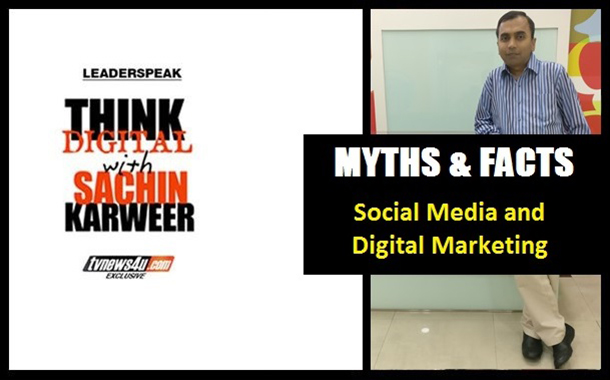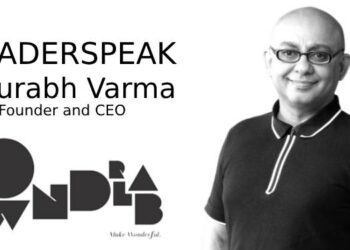By Sachin Karweer – Business Head – HGSi
In this, the sixth piece of the series Think Digital With Sachin Karweer, the author busts some myths about Social Media and Digital Marketing.
Any time is a good time to bust some Social Media and Digital Marketing myths, so let’s dig into the facts and uproot the myths.
With all the white noise, how does one differentiate between the information and the disinformation? This is one of the reasons that progressions in today’s technologies are hampered, despite their great potential, thus throwing a spanner in many a brand’s digital transformation. As the shift towards digital expands, the answers to the questions asked keep changing. This is a by-product of being in the age of progressing information and technology, and it must be addressed so your brand can take advantage of the immense opportunities available.
This time round, I shall attempt to debunk some of the myths revolving around social media and digital marketing, with the hopes of offering a fresh perspective to business owners.
Myth 1: It has an immediate effect and promises instantaneous results.
Fact: There are many businesses that go into digital expecting to see overnight success. Although, this is most certainly possible – we’ve seen it enough with brands whose content has gone viral, it must be made clear that this is an exception to the rule.
The relationship with your target audience is not absolutely instantaneous. It is a relationship that has to be nurtured and due diligence has to be practiced in order to garner steady and sturdy results. Besides taking time to create engaging quality content, it’s important to recognize and analyse your audience. After which, you will need sustained contact with your target audience so that they know who you are and what you can offer to them for your marketing tactics to work. Assessment and reassessment is necessary to stay on track with what works and what needs tweaking.
Myth 2: It is only for the young ‘uns and is pointless for an older target audience.
Fact: With millennials being called the ‘digital natives’, it’s easy for several sceptics to feel that social and digital are tools of and for the younger generations.
Younger people are, no doubt, the early adopters of social media but the older users are among the fastest growing demographics on most social media platforms at the moment. For those who are still apprehensive about it, just take a look around. The age-old forms of communication are slowly vanishing and social media is taking over.
Communication in the form of maps, phone books and news papers are also moving towards the internet. Social networks are becoming incredibly diverse, with users of all income brackets. This diversity means that most businesses can find their potential customers on social media platforms if they look for them. According to Jeff Bullas, 43% of those aged 65 years old and above are actively engaged on social media.
Businesses aware about this actively advertise on a number of senior-friendly sites, let us take the example of Sears, a renowned American department store. According to Quantcast, 62% of the visitors to Sears are above 50 years.
This proves that it could be a huge and costly mistake for businesses to miss out on connecting with and building relationships with these users. A study conducted by iProspect says that more than half of the people in the UK aged over 70 are on Facebook, and that figure rises to 62% for those aged 60 to 69 and 68% for 50- to 59-year-olds.
Myth 3: Social media and digital marketing is free.
Fact: Social media may be free, but social media marketing is most certainly not. Let me elaborate here, if you do not include advertising costs, the social media channels such as Facebook and Twitter are free to use. However, you have to take into account the costs of implementing a social digital marketing campaign – right from creating a strategy, developing content, publishing and advertising, assessing and analysing to managing a brand’s online customer relationship management. These take time and resources that do cost money. Therefore, it is important to consider your end goal and return on investment on these platforms.
Inbound and social media marketing involves extensive resources, people and time in order to be successful. Inbound marketing needs the creation and management of quality, relevant content and being active on the social networking platforms to build relationships with the target audiences. Though blogging, optimising profiles, responding to comments are time consuming, these are the most crucial tasks to perform.

Myth 4: A mobile website doesn’t make a lot of sense for small businesses.
Fact: I cannot reiterate how crucial it is for any business to have a mobile-friendly website these days. They are an indispensable requirement to create a better user experience. They are also cost-effective as small businesses can use one website that responds to all devices, be it a mobile, tablet or browser.
As mentioned in my previous article, there are 1.2 billion mobile web users worldwide with over 236 million mobile internet users in India, according to the IAMAI-KPMG report. It further projects that the mobile internet user base will reach 314 million by this year.
And it’s not just India, in 2015, more Google searches take place on mobile devices than on computers in 10 countries including the U.S. and Japan. Thus, proving that now is an ideal time to invest in a potential audience that will be mobile savvy.
Myth 5: The logo equals the brand.
Fact:Your brand is the perception the world has of your business, service and offerings. A brand isn’t just about your company colours, logo or your website; it is who you are as a company and the values you believe in.
It communicates your personality and influences your prospective customer’s opinion of who your brand is and whether they want to do business with you. Your brand needs to be used with consistence on all social media platforms, reflecting the personality of your business.
Myth 6: Marketing and advertising are the same.
Fact: Although marketing and advertising both have the same objectives and goals, they are distinct from each other and each has its own process. It is important for you to understand the difference between the two to help streamline your customer acquisition strategy.
Although you might use advertising to communicate messages about products and services, marketing is more about educating your target market about what you can offer them and why they should buy from you.
Advertising can be online or offline through newspapers, magazines, billboards, etc. Marketing is vital to create business visibility by educating your prospective customers about you, your products and services, and how you can help them solve a problem. It requires your investment in energy, resources, creativity and time. The more you invest in your marketing, the greater business success you will have.
Myth 7: Social media will immediately increase leads and sales.
Fact: Yes, it is possible to see an immediate rise in sales and leads, although, not every business will achieve this. Let me explain why and what I mean.
It is a known fact that the ecommerce industry has seen immense success in increasing their leads and sales in a quick manner using digital and social media. This is business specific, as customers are more likely to take quick calls on shopping sales than they would for a service based product that is on a higher product price scale.
Therefore, for service-based companies, increasing brand awareness, generating website traffic, current client engagement, and reputation management is the primary goal, not just generating sales.
Myth 8: My business does not need social media marketing.
Fact: That is not true. Technology is advancing at a great speed, which a company cannot afford to miss out on. Several companies face this dilemma of understanding whether they need social media marketing to run their business. It is wise to use social media now as opposed to planning it for the near future, as it will soon become an indispensable part of running a business.
It is a common misconception that B2B companies can benefit little from social media marketing. It is as relevant as it is for B2C businesses. Each and every company is social-media friendly and only need to know the right message and target audience.
With incredible growth in social media over the last few years, there are immense opportunities for almost any business in social media marketing. What companies need to do is connect with its particular target audience in the right place and focus on where the consumer attention goes. According to Facebook, an average Facebook user is connected to around 80 brand pages on the platform on brand pages, community pages and events.
According to Mashable, Google gets over 100 billion searches a month, with people searching for product information, online reviews and brand reputation that will help finalize their purchase decision. 81% of shoppers use this method of researching before buying; and even if businesses do not believe in the value of participating in social engagement on online platforms as part of their social media marketing, they cannot deny the value of a strong product presence in search results.
Myth 9: My business just needs a Facebook profile.
Fact: The average social media user has more than 5 accounts. To gain maximum brand awareness, it is better to maintain at least 2-4 channels that can reach and resonate the most with your target audience.
Myth 10: There is no return in social media marketing.
Fact: You will find several social media sceptics questioning the returns from social media marketing. All that socializing on social networks can be turned into a cash flow and the monetary return on social media marketing campaign can be measured, something that many businesses are already doing.
It is one of the fastest and highest demand careers in social media marketing. There are experts designated to monitor and measure the economic impact of digital marketing campaigns. In a nutshell, entwining social media in your business can generate great return on investments; the numerous successful start-ups in India are a living example of this. Irrespective of size, small as well as large independent retailers have tasted success in social media marketing, locally and globally.
Bonus Myth: If it’s doesn’t go viral, it’s not worth my time and money.
Fact: This is a topic of great interest in our industry and has been debated many a time. How does one measure success with digital and social media marketing? Mostly, a lot of people associate this success with viral elements. Yes, huge campaigns with enormous budgets have managed to hit the viral jackpot and reap millions of likes, shares and even follows, but let me tell you, that is not the only measure of success in the digital world.
Yes, getting a viral hit is what we strive to achieve, but think about it – the end goal of your presence online is to add value to your customers, connect and engage with them, nurture the relationship and create a brand that users are not just loyal to, but recommend to their connections.
Conclusion: It is now clear that each business has its own journey and path that is best suited to it, and there isn’t a one-size-fits-all solution available. It’s about exploring, trying, testing and tweaking until you find the formula that works the best for your businesses’ needs.
I would like to conclude that business owners need to look at digital and social media marketing as a child who needs the right direction, nurturing and caring to grow into a well-rounded adult that can gracefully support and carry the business forward.
















